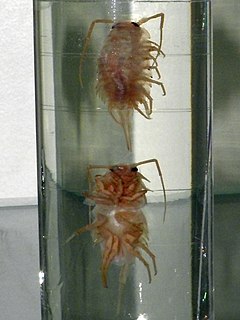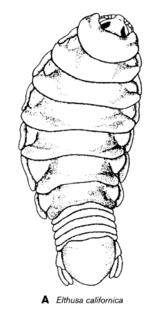
Isopoda is an order of crustaceans that includes woodlice and their relatives. Isopods live in the sea, in fresh water, or on land. All have rigid, segmented exoskeletons, two pairs of antennae, seven pairs of jointed limbs on the thorax, and five pairs of branching appendages on the abdomen that are used in respiration. Females brood their young in a pouch under their thorax.

Sphaeromatidae is a family of isopods, often encountered on rocky shores and in shelf waters in temperate zones. The family includes almost 100 genera and 619 known marine species. Within these genera, there are groups that share distinctive morphologies; further research may reclassify these genus-groups as separate families.

Pentidotea wonsnesenskii is a marine isopod which lives on seaweed on rocky shores along the British Columbia and Washington coastlines, as far south as San Francisco. It can be as large as 40 millimetres (1.6 in) long, with a concave tail rather than an indented tail as previously shown on this page, is usually green, but its colour is adaptable to its environment. It can often be found hiding under rockweed in the intertidal zone. It is named after the Russian biologist Ilya G. Voznesensky.

A giant isopod is any of the almost 20 species of large isopods in the genus Bathynomus. They are abundant in the cold, deep waters of the Atlantic, Pacific, and Indian Oceans. Bathynomus giganteus, the species upon which the generitype is based, is often considered the largest isopod in the world, though other comparably poorly known species of Bathynomus may reach a similar size. The giant isopods are noted for their resemblance to the much smaller common woodlouse, to which they are related.
Iais is a genus of isopod crustaceans. Iais species are found in association with larger isopods of the family Sphaeromatidae, usually on the ventral surface of the larger animal, between the pereiopods and on the pleopods. They are native to Australasia and South America, although Iais californica and its host Sphaeroma quoyanum have invaded California, and I. californica was first described from Sausalito, California. Nine species are recognised:

Idotea is a genus of isopod crustaceans, mostly from cold temperate waters. The taxonomy of the genus is still in doubt, and many of the currently recognised species may be taxonomic synonyms, and others may be moved to different genera. The genus Idotea includes the following species:

The Idoteidae are a family of isopod crustaceans. It includes these genera:

The Bopyridae are a family of isopod crustaceans in the suborder Cymothoida. There are 1223 individual species contained in this family. Members of the family are ectoparasites of crabs and shrimps. They live in the gill cavities or under the carapace where they cause a noticeable swelling. Fossil crustaceans have occasionally been observed to have a similar characteristic bulge.

Chiridotea is a genus of isopod crustaceans in the family Chaetiliidae, containing the following species:

Ligia cinerascens is a woodlouse in the family Ligiidae.

Harriet Richardson Searle was an American carcinologist. She was known as the first lady of isopods and was one of the first female carcinologists, with only Mary Jane Rathbun before her.
Exosphaeroma is a genus of marine isopod of the family Sphaeromatidae. This genus is found in shallow ocean waters worldwide. It is notable for being one of the few genera of sphaeromatid to be found in the southern reaches of the Southern Ocean. The greatest diversity of Exosphaeroma occurs in the Southern Hemisphere.
Exosphaeroma amplicauda is a species of marine isopod of the family Sphaeromatidae.

Mediaster is a genus of starfish in the family Goniasteridae. It was circumscribed in 1857 by William Stimpson for M. aequalis, the genus's type species. Its junior synonym is the genus Isaster, which was circumscribed in 1894 by Addison Emery Verrill for the species now known as M. bairdi. Verrill himself synonymized the two genus names in 1899.

Excirolana is a genus of isopods in the family Cirolanidae. There are about 15 described species in Excirolana.
Brackenridgia is a genus of woodlice in the family Trichoniscidae. There are about nine described species in Brackenridgia.

Elthusa californica is a species of isopod in the family Cymothoidae of the Isopoda Order. Elthusa californica is a
Elthusa is a genus of isopods in the family Cymothoidae. There are more than 30 described species in Elthusa.
Pentidotea resecata, the eelgrass isopod, is a species of isopod in the family Idoteidae. It is found in North America.
Pentidotea aculeata is a species of isopod in the family Idoteidae.












